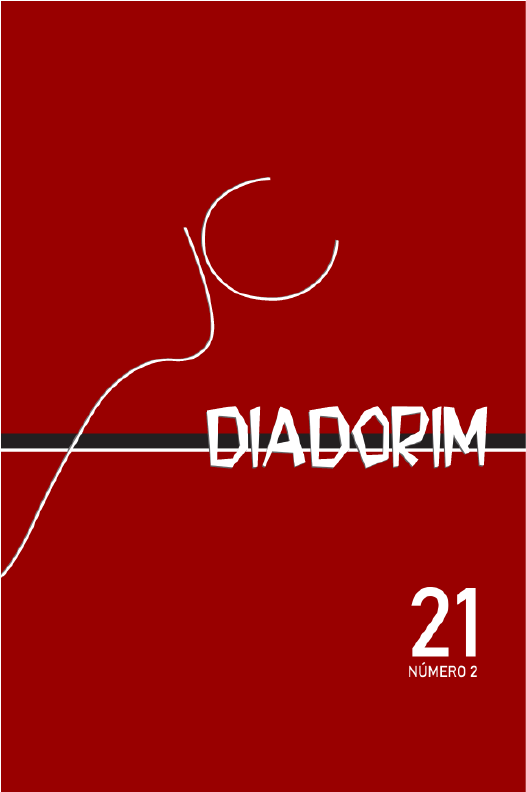IDENTIFYING WORD CATEGORIES IN MANDARIN CHINESE WITH CONSTRUCTIONAL APPROACH
DOI:
https://doi.org/10.35520/diadorim.2019.v21n2a28499Schlagworte:
word category, Construction Grammar, Mandarin Chinese, ge.Abstract
Ge as a classifier in Mandarin Chinese is typically followed by nouns. In the post-verbal position, ge is found to co-occur with prototypically non-nominal elements and the function of ge is unclear. This paper adopts a constructional approach to identify the word categories of the elements following ge in the post-verbal position. Instead of focusing on the elements in question alone, the constructions in which the elements occur are also taken into consideration. Within specific constructions, the elements following ge demonstrate variation in their grammatical behaviour. Their grammatical categories are determined by the constructions they occur in, not the preceding ge. In addition, within the Construction Grammar framework, the function of the post-verbal ge in these constructions is defined.
Literaturhinweise
AARTS, B. Modelling linguistic gradience. Studies in Language, 28, p. 1-50, 2004.
ALLAN, K. Classifiers. Language, 53(2), p. 285-311, 1977.
BORER, H. The projection of arguments. In: BENEDICTO, E.; RUNNER, J. (eds.) University of Massachusetts occasional papers in linguistics 17. Amherst: GLA, 1994, p. 19-48.
CHAO, Y-R. A Grammar of Spoken Chinese. Berkeley: University of California Press, 1968.
CHENG, L. L-S. Counting and classifiers. In: Massam, D. (ed.). Count and Mass Across Languages. Oxford: Oxford University Publish, 2012, p. 199-218.
CHIERCHIA, G. Reference to kinds across language. Natural Language Semantics, 6(4), p. 339-405, 1998.
CROFT, W. Radical Construction Grammar: Syntactic Theory in Typological Perspective. New York: Oxford University Press, 2001.
CROFT, W.; CRUSE, D. A. Cognitive Linguistics. Cambridge: Cambridge University Press, 2004.
CROFT, W. Beyond Aristotle and gradience: A reply to Aarts. Studies in Language, 31, p. 409-430, 2007.
FILLMORE, C. J.; KAY, P.; O' Connor, M. C. Regularity and idiomaticity in grammatical constructions: The case of let alone. Language, 64(3), p. 501-538, 1988.
GOLDBERG, A. E. Constructions: A Construction Grammar Approach to Argument Structure. Chicago: University of Chicago Press, 1995.
GOLDBERG, A. E. Construction grammar. In: Brown, E. K.; Miller, J. E. (eds.). Concise Encyclopedia of Syntactic Theories. New York: Elsevier Science Limited, 1997.
GOLDBERG, A. E. Surface generalizations: an alternative to alternations. Cognitive Linguistics, 13, p. 327-356, 2002.
GOLDBERG, A. E. Constructions at Work: The Nature of Generalization in Language. Oxford: Oxford University Press, 2006.
GÖTZ-VOTTELER, K. Describing semantic valency. In: Herbst, T.; Götz-Votteler, K. (eds.). Valency: Theoretical, Descriptive and Cognitive Issues. New York: Walter de Gruyter, 2007, p. 37-50.
HILPERT, M. Construction Grammar and Its Application to English. Edinburgh: Edinburgh University Press, 2014.
HOLLMANN, W. B. Nouns and Verbs in Cognitive Grammar: Where is the ‘sound’ evidence? Cognitive Linguistics, 24(2), p. 275-308, 2013.
LANGACKER, R. W. Foundations of Cognitive Grammar: Theoretical prerequisites. California: Stanford University Press, 1987.
LI, C. N.; Thompson, S. A. Mandarin Chinese: A Functional Reference Grammar. Berkeley: University of California Press, 1981.
LÜ, S. Ge Zi de Yingyong Fanwei, Fulun Danweici qian Yizi de Tuoluo 'The Uses of Ge as a Classifier, with Pemarks Concerning the Dropping of Yi before Ge and Other Classifiers'. Chinese Grammar:139-168. Beijing: Commercial Press, 1984.
LÜ, S. Xiandai Hanyu Babai Ci '800 Words of Modern Chinese'. Beijing: Commercial Press, 1999.
MYERS, J. Rules vs. analogy in Mandarin classifier selection. Language and Linguistics, 1(2), p. 187-209, 2000.
RIJKHOFF, J. When can a language have adjectives? An implicational universal. In: VOGEL, P. M.; COMRIE, B. (eds.) Approaches to the Typology of Word Classes. Berlin: Mouton de Gruyter, 2000, p. 257-275.
SACKMANN, R. The problem of ‘adjectives’ in Mandarin Chinese. SACHMANN, R. (ed.) Theoretical linguistics and grammatical description. Amsterdam: Benjamins, 1996, p. 257-275.
SHANG, X. Aspect, Event and 'V ge VP' Construction. Journal of Foreign Languages, 32(5), 28-37, 2009.
SHEN, J. "Rouhe he Jieda 'Blending and Compounding'." International Chinese Education, 4, p. 5-12, 2006.
SHI, Y.; LEI, Y. The Object Marking Function of ge. Chinese linguistics research (4), p. 14-19, 2004.
SONG, Y. Liangci 'ge' he Zhuci 'ge' 'Classifier ge and Structural Auxiliary ge'." Thinking and Wisdom, 6, p. 44-45, 1993.
TAI, J. H.-Y. Chinese Classifier Systems and Human Categorization. In CHEN, M.; TZENG, O. (eds.). Essays in Honor of Professor William S-Y. Wang. Taipei: Pyramid Publishing Company, 1994, p. 205-238.
TENNY, C. Grammaticalizing aspect and affectness. Doctoral dissertation, MIT. 1987.
WU, X. Z. Grammaticalization and Language Change in Chinese: A formal view. London: Routledge, 2004.
WU, H. Jiegou Zhuci 'ge' he 'dong+ ge +bu' shi jiegou 'structual auxiliary ge and v+ge+complement structure'. Journal of Zhongzhou, 3, p. 100-104, 1982.
YOU, R. Buyu de Biaozhi 'ge' he 'de' 'The complement markers ge and de'. Chinese Language Learning, 3, p. 18-19, 1983.
ZHANG, Y. From a measure word to an auxiliary word – a case study of the grammaticalization of the Chinese measure word ge. Modern Linguistics, 5(3), p. 193-205. 2003.
ZHOU, M. Grammaticalization features of Chinese classifier ge. Journal of Chinese Linguistics, 1, p. 41-44, 2002.
ZHU, D. YuFa JiangYi 'Grammar Textbook'. Beijing: Commercial Press,1982.
ZHU, K. On 'ge' in Structure 'V+ge+A/V'. Chinese Study, 3, p. 16-19, 2000.
Downloads
Veröffentlicht
Ausgabe
Rubrik
Lizenz
Transferência de direitos autorais - Autorização para publicação
Caso o artigo submetido seja aprovado para publicação, já fica acordado que o autor autoriza a UFRJ a reproduzi-lo e publicá-lo na Diadorim: Revista de Estudos Linguísticos e Literários, entendendo-se os termos "reprodução" e "publicação" conforme definição respectivamente dos incisos VI e I do artigo 5° da Lei 9610/98. O artigo poderá ser acessado pela internet, a título gratuito, para consulta e reprodução de exemplar do artigo para uso próprio de quem a consulta. Essa autorização de publicação não tem limitação de tempo, ficando a UFRJ responsável pela manutenção da identificação do autor do artigo.

A Revista Diadorim utiliza uma Licença Creative Commons Atribuição-NãoComercial 4.0 Internacional (CC BY-NC 4.0).

